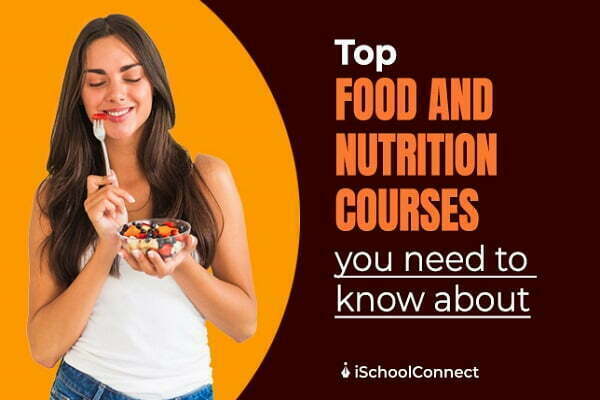Table of Contents
- Introduction | What is a Food and Nutrition Course?
- What does a Food Nutritionist do?
- Skills Required to be a Food Nutritionist
- Food and Nutrition Course Syllabus
- Nutritional terms –
- Nutritive value of food –
- Digestion and absorption –
- Meal planning and dietary guidelines –
- Composition and value of the main foods in the diet
- Convenience foods
- Basic proportions and methods of making
- Raising agents
- Food preservation
- Kitchen planning
- Kitchen equipment
- Kitchen safety and first aid
- Top Universities for Pursuing Food and Nutrition Course
- Food and Nutrition Course Eligibility
- Other requirements
- Food and Nutrition Course Fees
- Food and Nutrition Course | Career options
- Salary of a Food Nutritionist
- Key Takeaways
- FAQs
Introduction | What is a Food and Nutrition Course?
A food and nutrition course is a learning process that will give you the skills required to research, process, and preserve the nutritional components in our food. The dietary components are proteins, carbohydrates, vitamins, fiber, minerals, and fat. The scope in food and nutrition courses is broad. You can choose a degree in food microbiology, study nutrition for fitness and sports, explore nutrition for obesity or malnutrition, or study nutrition and diet for diseases, to name a few.
Read more: Top 8 food technology courses worldwide!
What does a Food Nutritionist do?
All in all, food nutritionists provide customized plans and information for people trying to lose weight and eat healthily. They even guide diabetic patients on how to control their blood sugar. In addition to this, food nutritionists also guide specific individuals like dieticians as and when needed.
Typically, the job of a nutritionist includes the following –
- Explain nutrition to the client and the benefits of following a nutritious and healthy diet.
- Prepare suitable meal plans while keeping food preferences and costs in mind.
- In addition, the effects of the meal plan must be continuously evaluated, and the necessary changes must be made.
- Additionally, educate everyone about the importance of good nutrition and how healthy eating prevents diseases.
Skills Required to be a Food Nutritionist
Perseverance and hard work are essential and critical for any job. However, apart from those, having the right skills is also quintessential. All in all, a food nutritionist should have the following skills–
- Communication skills
- Ability to work late nights
- Ability to learn and upgrade
- Decision-making skills
- Leadership skills
- Creativeness
Read more: Food Technology in the USA | A comprehensive guide
Food and Nutrition Course Syllabus
The food and nutrition course syllabus is generally divided into 14 topics designed to develop students’ knowledge and skills in an area relevant to their own lives and also through understanding where food and nutrition fit in the modern, changing, multicultural society.
Nutritional terms –
Understand the terms used in nutrition and nutrition-related problems: Diet, balanced diet, metabolism, malnutrition, undernutrition, overnutrition, deficiency disease.
Nutritive value of food –
The sources and functions of:
- proteins (high biological and low biological value), carbohydrates (monosaccharide, disaccharide and polysaccharide)
- fats
- vitamins (A, C, D, E, K, B group – thiamin, riboflavin, nicotinic acid and cobalamin)
- mineral elements (calcium, iron, phosphorous, potassium, sodium, fluoride, chloride, iodide)
- water
Sources and uses of food energy.
Sources and functions of non-starch polysaccharide (NSP)/dietary fibre.
Digestion and absorption –
Digestion at each stage of the digestive system:
- mouth
- stomach
- duodenum
- ileum
Enzymes as catalysts in digestion, including amylase, carboxypeptidase, invertase, lactase, lipase, maltase, pepsin, rennin, trypsinogen.
Role of bile in emulsifying fats.
Absorption of nutrients, including the structure of the ileum.
Meal planning and dietary guidelines –
Factors affecting food requirements.
Planning and serving of family meals.
Meals for different ages, occupations, cultures and religions.
Special needs of:
- pregnant and lactating women
- people with food allergies and intolerances, including coeliacs
- people with medical conditions linked to diet, such as diabetes
- convalescents
- vegetarians, including vegans and lacto-vegetarians
Meals for special occasions, festivals, packed meals, snacks, beverages.
Use of herbs, spices and garnishes.
Attractive presentation of food.
Terminology describing recommended dietary intakes, e.g. Dietary
Reference Value (DRV) and Reference Daily Intake (RDI).
Use of nutritional tools.
Composition and value of the main foods in the diet
Sources of protein (dairy products, eggs, fish, meat, soya); cereals (maize, millets, oats, rice, wheat); fruits and vegetables, including pulses and nuts; fats and oils.
Cooking of food
Transfer of heat by conduction, convection and radiation. Principles involved in the different methods of cooking – baking, boiling, braising, cooking in a microwave oven, frying, grilling, poaching, pressure cooking, roasting, simmering, steaming, stewing, use of a slow cooker.
Reasons for cooking food.
Sensory properties of food (flavour, taste, texture).
Effect of dry and moist heat on proteins, fats and oils, sugars and starches, and vitamins to include:
- caramelisation
- coagulation
- dextrinisation
- enzymic and non-enzymic browning (Maillard reaction)
- gelatinisation
- rancidity
- smoking point
Preparation and cooking of food to preserve nutritive value.
Economical use of food, equipment, fuel and labour.
Convenience foods
Foods partly or prepared by a food manufacturer – dehydrated, tinned, frozen, ready-to-eat, cook-chill.
Intelligent use of these foods.
Advantages and disadvantages.
Food additives – types and functions.
Packaging – types, materials used, advantages and disadvantages.
Labelling – information found on labels, reasons for it.
Basic proportions and methods of making
Biscuits, cookies, scones and cakes are made using creaming, melting, one-stage, rubbing-in, and whisking methods.
Pastries – shortcrust, flaky and rough puff.
Sauces – pouring and coating; roux and blended methods.
Batters – thin (pouring) and coating.
Sweet and savoury yeast products.
Raising agents
Air, carbon dioxide, water vapour.
Ways of introducing these gases into a mixture (to include bicarbonate of soda, baking powder, yeast).
Food spoilage and hygiene
Action of enzymes, bacteria, yeasts and molds.
Personal, food and kitchen hygiene, including food hygiene in shops and markets.
Food storage at home, refrigeration, waste disposal.
Food preservation
Reasons for preserving food.
Methods of preservation and an understanding of the principles involved:
- heating – canning, bottling
- removal of moisture – dehydrating
- reduction in temperature – freezing
- chemical preservation – sugar, salt, vinegar
- modified atmosphere packaging
- irradiation
Key points involved in milk pasteurisation and sterilisation, as well as in producing UHT milk, evaporated and condensed milk, and dried milk.
The use of enzymes and bacteria in the manufacture of cheese and yoghurt.
Kitchen planning
Organise the cooking area and equipment for efficient work.
Choice, use and care of:
- work surfaces
- flooring
- walls and wall coverings
- lighting
- ventilation
Kitchen equipment
Choice, use and care of:
- modern cookers
- thermostatic control and automatic time-controlled ovens
- microwave ovens
- slow electric cook pots
- refrigerators and freezers
- small kitchen equipment, e.g. knives, pans
- small electrical kitchen equipment, e.g. food processors, electric kettles
Advantages and disadvantages of microwave ovens.
Kitchen safety and first aid
Awareness of potential danger areas in the kitchen.
Safety precautions.
First aid for burns and scalds, cuts, electric shock, fainting, shock
Top Universities for Pursuing Food and Nutrition Course
As a matter of fact, food and nutrition courses are gaining popularity across the globe. However, some of the most highly-rated universities offering courses related to food and nutrition are:
- Swiss Federal Institute of Technology, Switzerland
- New York University, United States of America
- Boston University, United States of America
- University of Nottingham, United Kingdom
Read more: Nutrition & Dietetics Course – Types, Syllabus, and Job Opportunities!
Food and Nutrition Course Eligibility
As a matter of fact, anyone can apply for a food and nutrition course, whether for undergraduate or postgraduate. However, you have to meet a few standard criteria.
For candidates who are aiming to take Food and Nutrition Courses after 12th:
- Admit card showing that the candidate has passed or appeared for the class 12th examination from a reputed board of education.
- The candidate should have scored at least 50% marks in the examinations. Some colleges, however, do not ask for a minimum mark requirement for diploma courses.
For postgraduate courses, the criteria for application are slightly different. The requirements for food and nutrition courses are –
- Candidates must have a complete Bachelor’s degree in a relevant stream.
- Candidates should have scored at least 55% in the qualifying degree exam.
In addition to this, please visit the university websites to learn more about the eligibility criteria for pursuing a food and nutrition course because the requirements may vary here and there.
Other requirements
However, all universities abroad have the following criteria in common –
- Transcripts
Start collecting all documents six months before applying to colleges and universities. Once you get a letter of acceptance, you can use it to apply for your student visa and even a scholarship.
Discover: Scope of Bachelors in Food science abroad
Food and Nutrition Course Fees
While opting to study abroad, the cost of education significantly increases; in addition to higher university fees, there is a higher cost of living, transportation, and other expenses. All in all, studying abroad will cost USD 15,000 to USD 25,000. Apply for a scholarship as it helps reduce the cost of living and studying abroad.
Discover: Interesting facts and details about world food day!
Food and Nutrition Course | Career options
As a matter of fact, you have enriching career options after pursuing a food and nutrition course. However, some of the most popular job profiles are –
- Food technologist
- Dietician
- Nutritionist
- Food research analyst
- Food inspector
Know more: About the National food security card
Salary of a Food Nutritionist
A food and nutrition course will help you get a high salary, depending on your educational background, experience, and interest in the subject. All in all, you can get a starting package of up to INR 5,00,000 per annum.
Key Takeaways
Summarizing the blog,
- As the food and nutrition course is gaining popularity worldwide, it is an excellent career choice.
- As a matter of fact, many avenues are available to you, starting from sports nutrition, dieticians, health coaches, or analysts.
- Food nutritionists always come in handy in today’s age, where people are becoming more health-conscious and sustainable.
- If you want more information, get in touch with us.
Go ahead; the world is your oyster!
Liked this blog? Then read: Courses after 12th Science Biology | Learn about the top 7 courses!
FAQs
Ques 1: What documents are needed to apply for a university overseas?
Answer 1: Applicants must check the respective university’s website to know the exact specific requirements and food and nutrition course details. All the universities require standard documents: a letter of recommendation, transcripts, statement of purpose, and proof of an English language exam.
Ques 2: What is the cost of studying for this course?
Answer 2: All in all, the cost of studying food and nutrition courses varies from university to university. However, the average fee for this course can range anywhere from USD 15,000 to USD 25,000.
Ques 3. What are the job opportunities that this course provides?
Answer 3: As a matter of fact, many career options are available on completion of the food and nutrition course. However, some top ones are sports nutrition specialists, obesity and diabetes management, etc.
Ques 4: What are the food and nutrition courses online?
Answer 4: These are the online food and nutrition courses in India:
- AAFT Online – Diploma in Nutrition and Dietetics
- Advanced Diploma in Diet and Nutrition
- VLCC Institute of Beauty and Nutrition







I want to be connected to study abroad. Please help me. Thanks.
Hey,
One of our counselors will get in touch with you soon!
All the best.
You can also contact us-
Email- info@ischoolconnect.com
Phone +91 9145332283
How can I enroll to study
Hey,
One of our counselors will get in touch with you soon!
All the best.
You can also contact us-
Email- info@ischoolconnect.com Phone +91 9145332283